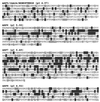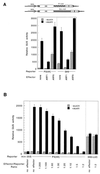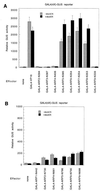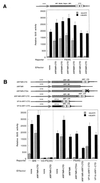Activation and repression of transcription by auxin-response factors
- PMID: 10318972
- PMCID: PMC21948
- DOI: 10.1073/pnas.96.10.5844
Activation and repression of transcription by auxin-response factors
Abstract
Auxin-response factors (ARFs) bind with specificity to TGTCTC auxin-response elements (AuxREs), which are found in promoters of primary/early auxin-response genes. Nine different ARFs have been analyzed for their capacity to activate or repress transcription in transient expression assays employing auxin-responsive GUS reporter genes. One ARF appears to act as a repressor. Four ARFs function as activators and contain glutamine-rich activation domains. To achieve transcriptional activation on TGTCTC AuxREs in transient expression assays, ARFs require a conserved dimerization domain found in both ARF and Aux/IAA proteins, but they do not absolutely require their DNA-binding domains. Our results suggest that ARFs can activate or repress transcription by binding to AuxREs directly and that selected ARFs, when overexpressed, may potentiate activation further by associating with an endogenous transcription factor(s) (e.g., an ARF) that is bound to AuxREs. Transfection experiments suggest that TGTCTC AuxREs are occupied regardless of the auxin status in cells and that these occupied AuxREs are activated when exogenous auxin is applied to cells or when ARF activators are overexpressed. The results provide new insight into mechanisms involved with auxin regulation of primary/early-response genes.
Figures




Similar articles
-
Dimerization and DNA binding of auxin response factors.Plant J. 1999 Aug;19(3):309-19. doi: 10.1046/j.1365-313x.1999.00538.x. Plant J. 1999. PMID: 10476078
-
The roles of auxin response factor domains in auxin-responsive transcription.Plant Cell. 2003 Feb;15(2):533-43. doi: 10.1105/tpc.008417. Plant Cell. 2003. PMID: 12566590 Free PMC article.
-
Aux/IAA proteins contain a potent transcriptional repression domain.Plant Cell. 2004 Feb;16(2):533-43. doi: 10.1105/tpc.017384. Epub 2004 Jan 23. Plant Cell. 2004. PMID: 14742873 Free PMC article.
-
The ARF family of transcription factors and their role in plant hormone-responsive transcription.Cell Mol Life Sci. 1998 Jul;54(7):619-27. doi: 10.1007/s000180050190. Cell Mol Life Sci. 1998. PMID: 9711229 Free PMC article. Review.
-
Auxin-responsive gene expression: genes, promoters and regulatory factors.Plant Mol Biol. 2002 Jun-Jul;49(3-4):373-85. Plant Mol Biol. 2002. PMID: 12036261 Review.
Cited by
-
MicroRNA167-Directed Regulation of the Auxin Response Factors GmARF8a and GmARF8b Is Required for Soybean Nodulation and Lateral Root Development.Plant Physiol. 2015 Jul;168(3):984-99. doi: 10.1104/pp.15.00265. Epub 2015 May 4. Plant Physiol. 2015. PMID: 25941314 Free PMC article.
-
Identification of potential Auxin Response Candidate genes for soybean rapid canopy coverage through comparative evolution and expression analysis.bioRxiv [Preprint]. 2023 Oct 31:2023.10.26.564213. doi: 10.1101/2023.10.26.564213. bioRxiv. 2023. Update in: Front Plant Sci. 2024 Oct 03;15:1463438. doi: 10.3389/fpls.2024.1463438. PMID: 37961442 Free PMC article. Updated. Preprint.
-
IGT/LAZY genes are differentially influenced by light and required for light-induced change to organ angle.BMC Biol. 2024 Jan 17;22(1):8. doi: 10.1186/s12915-024-01813-4. BMC Biol. 2024. PMID: 38233837 Free PMC article.
-
Ustilaginoidea virens Nuclear Effector SCRE4 Suppresses Rice Immunity via Inhibiting Expression of a Positive Immune Regulator OsARF17.Int J Mol Sci. 2022 Sep 10;23(18):10527. doi: 10.3390/ijms231810527. Int J Mol Sci. 2022. PMID: 36142440 Free PMC article.
-
Integrative omics approaches revealed a crosstalk among phytohormones during tuberous root development in cassava.Plant Mol Biol. 2022 Jun;109(3):249-269. doi: 10.1007/s11103-020-01033-8. Epub 2020 Aug 5. Plant Mol Biol. 2022. PMID: 32757126
References
-
- Ulmasov T, Hagen G, Guilfoyle T J. Science. 1997;276:1865–1868. - PubMed
Publication types
MeSH terms
Substances
Associated data
- Actions
- Actions
- Actions
- Actions
- Actions
LinkOut - more resources
Full Text Sources
Other Literature Sources
Molecular Biology Databases

